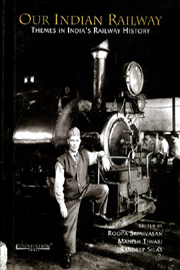Book contents
- Frontmatter
- Contents
- Foreword
- Preface
- Introduction
- 1 The Colonial Context of the Bengal Renaissance: A Note on Early Railway–Thinking in Bengal
- 2 Minute by Dalhousie on Introduction of Railways in India, as Submitted to the Court of Directors, 4 July 1850
- 3 Ackworth Committee Report
- 4 Competition and Adaptation: The Operation of Railways in Northern India: Uttar Pradesh 1860–1914
- 5 Economic Nationalism and the Railway Debate, circa 1880-1905
- 6 Railway Policing and Security in Colonial India, c. 1860–1930
- 7 Indian Nationalism and Railways
- 8 The Railway in Colonial India: Between Ideas and Impacts
- 9 The Dark Side of the Force: Mistakes, Mismanagement and the Malfeasance in Early Railways of the British Indian Empire
- 10 Tunnels and Bridges: Railways, Narrative and Power in two Novels of India
- 11 A View of the History of Indian Railways
- 12 The Romance of Steam
- Index
- Plate section
Preface
Published online by Cambridge University Press: 26 October 2011
- Frontmatter
- Contents
- Foreword
- Preface
- Introduction
- 1 The Colonial Context of the Bengal Renaissance: A Note on Early Railway–Thinking in Bengal
- 2 Minute by Dalhousie on Introduction of Railways in India, as Submitted to the Court of Directors, 4 July 1850
- 3 Ackworth Committee Report
- 4 Competition and Adaptation: The Operation of Railways in Northern India: Uttar Pradesh 1860–1914
- 5 Economic Nationalism and the Railway Debate, circa 1880-1905
- 6 Railway Policing and Security in Colonial India, c. 1860–1930
- 7 Indian Nationalism and Railways
- 8 The Railway in Colonial India: Between Ideas and Impacts
- 9 The Dark Side of the Force: Mistakes, Mismanagement and the Malfeasance in Early Railways of the British Indian Empire
- 10 Tunnels and Bridges: Railways, Narrative and Power in two Novels of India
- 11 A View of the History of Indian Railways
- 12 The Romance of Steam
- Index
- Plate section
Summary
Writing about issues connected to a railway system like Indian Railways is not easy as it has long before crossed the boundaries of a machine system to a domain that is human. That is where the railway now dwells amidst memories of Mahatma Gandhi, the killings during Partition, the uncalled for stoppages in times of agitation, and the present day role of companion, relief and relaxation, business accomplice and friend. It is a system that is as much loved by its people as it is abused. The ‘150th Year of Railways in India’ deserved a book and so it was proposed and so it was decided by the Railway Board.
Considering the intricate complexities of the railway system in India, its strengths and weaknesses, we decided to indulge in a study of the related academic and social magnetic field that is active around the railway. Documenting history would not have been as difficult a proposition as this. For here are the influences of the railway, those that grew into the community as catalysts of change in social and cultural life. The railway ran its miles; life its generations.
What began as a tiny scratch upon the face of western India grew into a colossal network in 150 years binding India socially, connecting culturally, strengthening India economically and changing India forever. Here was a powerful force that cut into the rigid caste system of India more incisively than any political doctor. It gave the Indian citizen the anonymity he deserved, away from the distinctive paste of caste worn on the forehead. It gave the village the opportunity it desired to bond with the city.
- Type
- Chapter
- Information
- Our Indian RailwayThemes in India's Railway History, pp. ix - xiiPublisher: Foundation BooksPrint publication year: 2006

